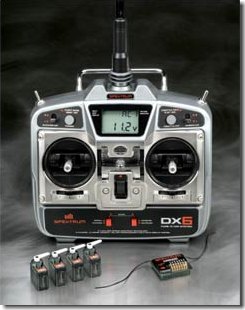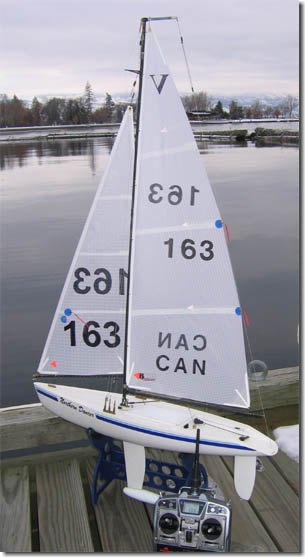Spektrum DX6 Radio System
By James Anderson, Okanagan Model Sailboat Association
 The first example of a Spektrum DX6 2.4GHz radio system was received here at the boat building shop of the Okanagan Model Sailboat Association one day prior to these tests and was quickly installed in "Northern Dancer", a reasonably competitive example of a Victoria class sailboat. The DX6 radio system was designed for the difficult environment of model aircraft and helicopters and has more control functions (six) than can be implemented in most of our sailboats. This unique 2.4GHz radio system finds its own “free radio channels” each and every time the system is turned on which overcomes the serious problem of radio frequency allocation during regattas or even recreational sailing events. There is no limitation on surface/aircraft usage with this new radio band, quite unlike the older 27 and 75MHz band radio systems.
The first example of a Spektrum DX6 2.4GHz radio system was received here at the boat building shop of the Okanagan Model Sailboat Association one day prior to these tests and was quickly installed in "Northern Dancer", a reasonably competitive example of a Victoria class sailboat. The DX6 radio system was designed for the difficult environment of model aircraft and helicopters and has more control functions (six) than can be implemented in most of our sailboats. This unique 2.4GHz radio system finds its own “free radio channels” each and every time the system is turned on which overcomes the serious problem of radio frequency allocation during regattas or even recreational sailing events. There is no limitation on surface/aircraft usage with this new radio band, quite unlike the older 27 and 75MHz band radio systems.
The technical manual accompanying the radio system was easy to follow and the receiver and the transmitter were fully operational in Northern Dancer in less than 1 hour of starting the install. As the DX6 radio system was originally intended for use by R/C aircraft and R/C helicopters, there are many control features that may be glossed over in a simple sailboat installation. The sail servo was inserted into the “throttle” connector of the receiver (controlled by the left stick of the transmitter) while the rudder servo was inserted into the “aileron” connector. (controlled by the right stick)
The existing Futaba battery holder and power switch in Northern Dancer were kept in place and were compatible with the DX6 receiver. Note that the DX6 receiver does not come with a battery holder or switch assembly and will need to be purchased separately.
The DX6 dual receiver weighs only 7. 5 grams and comes complete with two small antennas, each less than 4 inches in length. This dual digital receiver system should prove to provide unparalleled control reliability. The end of one short antenna was fastened to the inside starboard surface of the hull while the end of the second antenna was taped to the port inside surface of the hull.
Bench tests of the system found it to be perfectly compatible with the existing rudder servo (a Futaba S3003) and the sail servo (a Futaba S3802) that were in Northern Dancer. A nice feature of this radio system was noticed in the ability to either reduce or increase the travel of either servo from normal. In addition, the servos can be made to travel a different amount in each direction, allowing for asymmetrical servo linkages (as in the Victoria rudder linkage).
 The right stick of the transmitter comes standard with spring-loaded automatic centering which perfectly suits our use as the rudder control, while the left stick comes with the "ratchet" friction device on it which is ideal for our use as the sail control.
The right stick of the transmitter comes standard with spring-loaded automatic centering which perfectly suits our use as the rudder control, while the left stick comes with the "ratchet" friction device on it which is ideal for our use as the sail control.
The transmitter has a push-button switch on the rear of the unit which temporarily and significantly reduces the transmitter power. This feature provides for a quick reliability check under artificially impaired conditions.
The very short transmitter antenna will be surely be convenient and safer during sailing events.
The four Spektrum S75 servos that came with the DX6 system were then weighed (7.5 grams) and then tested for travel and torque and were determined to be suitable for use in the Victoria as a rudder servo. Their small size and low weight should be attractive for those boats that find themselves a bit overweight. The existing Futaba S3003 servo was removed from "Northern Dancer" and the Spektrum S75 servo installed in its place to control the Victoria's rudder. This servo swap was easily accomplished with the use of a replacement lightweight servo mounting assembly as described in the OMSA step-by-step web-based instructions (www.legacyfamilytree.ca/sail).
After an overnight charge of the supplied 600 mah NiCd transmitter battery in the DX6, "Northern Dancer" received a range and battery life test. The sailboat was positioned outside the shop on its display stand while the controlling transmitter was carried down the street. An observer stayed with the Victoria noting any loss of control while the rudder was occasionally "wagged" and the distance between the boat and the transmitter was paced off. Absolutely no loss of control was observed at any time and the test was terminated at a distance of 700 feet. The supplied 600 mah NiCd transmitter battery was tested and shown to be adequate for 2 1/2 hours of steady use before requiring use of the recharger included in the package.
The trials were continued without incident on the waters of Okanagan Lake with other Victoria class sailboats and at ranges up to 500 feet, which was well beyond the distance to any of our course marks.
The overall design and implementation of this revolutionary radio control system by the engineering staff at SpektrumRC would appear to be excellent and clearly sets a new standard for R/C radio systems. This new technology is currently available from "Great Hobbies" in Canada at: www.greathobbies.com
A replacement 9.6 volt NiCd Sanyo 1100 mah battery pack can be ordered under the Great Hobbies part number: GHP110N8SS. An alternative battery is the higher capacity 9.6 volt NiMH Sanyo 2300 mah pack: Great Hobbies part number GHP230M8S.
The Hitec 4-AA battery box (HIT7201) and Futaba switch harness (FUTSWH12) should be suitable for the Spektrum receiver in the sailboat and additional Spektrum AR6000 DuaLink receivers (SPM6000) can be ordered seperately.

